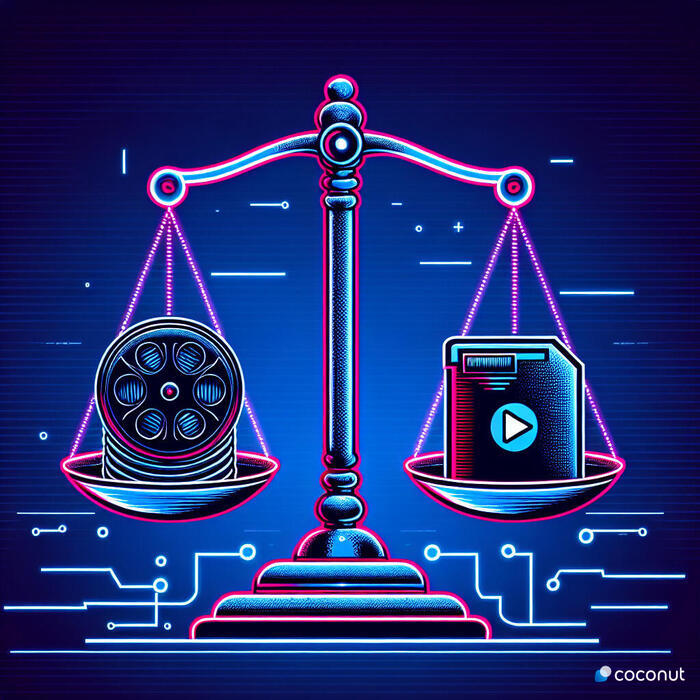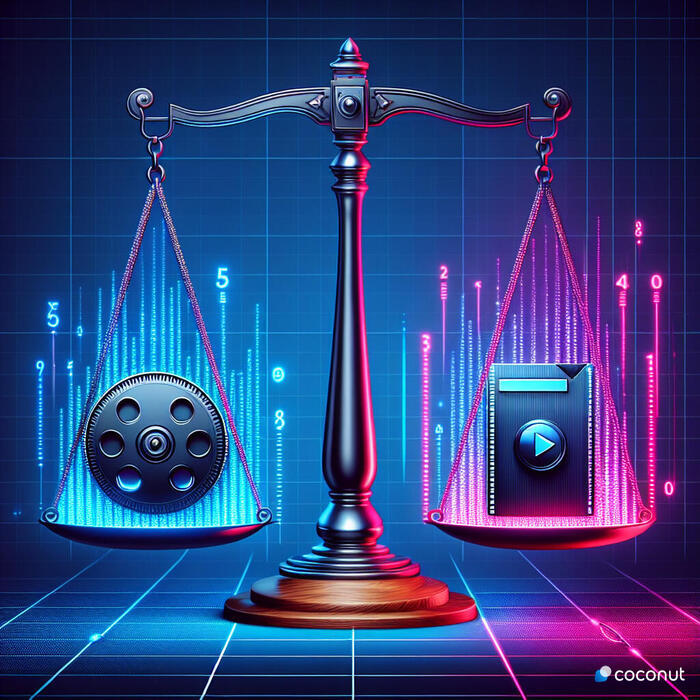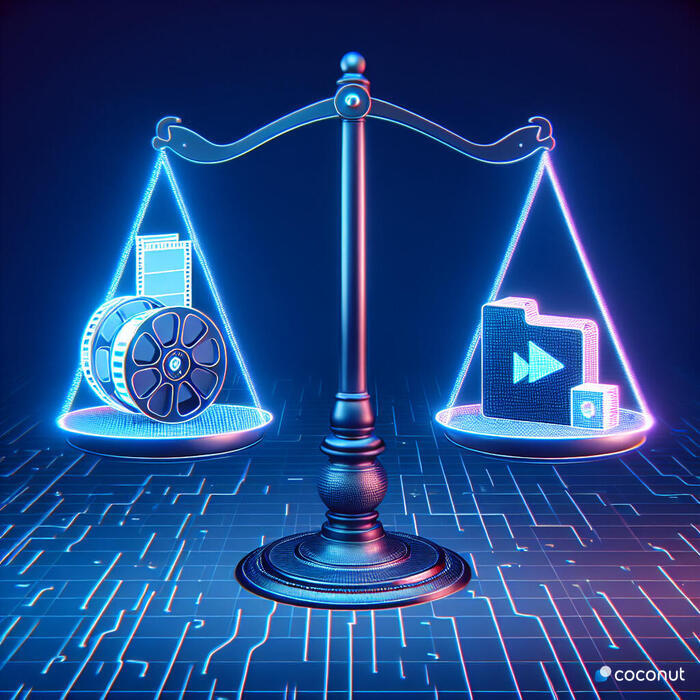Are you looking to strike the perfect balance between video quality and file size? You're in the right place! We'll guide you through the process of optimizing compression settings to achieve high-quality output without ending up with excessively large files. Let's get started!

Understanding Video Compression
Basics of Video Compression
Video compression is a fascinating process that plays a crucial role in determining the quality and size of your video files. At its core, video compression involves reducing the amount of data in a video file without significantly impacting its visual quality. This is achieved through the use of codecs, bitrates, and compression algorithms.
Codecs, short for coder-decoder, are software or hardware that compresses data for transmission and then decompresses it for viewing or editing. Different codecs have different compression efficiencies and may affect the quality and size of your video files differently. Some popular codecs include H.264, H.265, and VP9.
Bitrate, on the other hand, refers to the amount of data processed per unit of time, usually measured in kilobits per second (Kbps). A higher bitrate generally means better video quality but also a larger file size. Therefore, choosing the right bitrate is a balancing act between quality and size.
Lastly, compression algorithms determine how data is compressed and decompressed. They can be as simple as removing redundant data or as complex as predicting future data based on past data. The choice of compression algorithm can significantly impact the quality and size of your video files.
Lossy vs. Lossless Compression
When it comes to video compression, there are two main methods: lossy and lossless. Understanding the difference between these two can help you make informed decisions about your video compression settings.
Lossy compression reduces file size by permanently eliminating certain information, especially redundant or less important data. This method can significantly reduce file size but may also lead to a noticeable loss in video quality, especially if the compression is severe. Common lossy codecs include H.264 and H.265.
Lossless compression, as the name suggests, compresses data without losing any information. This method results in higher quality videos but also larger file sizes compared to lossy compression. Examples of lossless codecs include Apple ProRes and GoPro CineForm.

Choosing between lossy and lossless compression depends on your specific needs. If file size is a concern and a slight loss in quality is acceptable, lossy compression might be the way to go. However, if quality is paramount, lossless compression is your best bet.
Common Video File Formats
Video file formats are another important aspect of video compression. Different formats have different compression characteristics and may be more suitable for certain applications than others.
MP4, for example, is a popular video file format that uses the H.264 codec for compression. It provides good video quality and is widely supported by various platforms and devices, making it a versatile choice for many applications.
AVI, on the other hand, is a less compressed format that offers high quality but also larger file sizes. It's a good choice if quality is your top priority and file size is not a concern.
MOV, developed by Apple, is another common video file format. It uses a variety of codecs, including both lossy and lossless ones, and is compatible with both Mac and Windows systems.
Choosing the right video file format depends on your specific needs and the platforms and devices you're targeting. It's always a good idea to experiment with different formats to see which one works best for you.
Factors Affecting Video Quality and Size
Resolution and Aspect Ratio
Resolution and aspect ratio are two key factors that can influence the quality and size of your video files. Let's take a closer look at each of them.

Resolution refers to the number of pixels displayed on the screen. Higher resolution means more pixels, which results in sharper and clearer images. However, it also means larger file sizes. Therefore, choosing the right resolution is a balancing act between quality and size. For example, 4K resolution offers stunning quality but can result in large file sizes, while 1080p or 720p might be more suitable if file size is a concern.
Aspect ratio, on the other hand, is the ratio of the width to the height of the video. Common aspect ratios include 4:3 (standard TV), 16:9 (widescreen TV), and 1.85:1 (cinema). The choice of aspect ratio can affect the viewing experience and should be chosen based on the target viewing platform and audience preferences.
Remember, the goal is to strike the right balance between quality and size. While higher resolution and wider aspect ratios can enhance the viewing experience, they can also result in larger file sizes. Therefore, it's important to consider your specific needs and constraints when choosing resolution and aspect ratio.
Frame Rate Considerations
Frame rate is another important factor that can influence video quality and size. It refers to the number of frames displayed per second, usually measured in frames per second (fps).
A higher frame rate can make the video appear smoother and more realistic, especially for fast-paced action scenes. However, it also means more data to process and therefore larger file sizes. Common frame rates include 24 fps (cinema), 30 fps (TV), and 60 fps (high-definition video).
Choosing the right frame rate depends on the content of your video and the viewing platform. For example, if you're creating a fast-paced action video, a higher frame rate might be beneficial. However, if you're creating a simple presentation or tutorial, a lower frame rate might be sufficient and can help reduce file size.
In conclusion, optimizing video quality vs. file size involves understanding and balancing various factors, including video compression, resolution, aspect ratio, and frame rate. By carefully considering these factors and making informed decisions, you can achieve high-quality output without excessively large files. Happy video creating!

Bitrate: Balancing Quality and Size
When it comes to video quality, bitrate is a crucial factor to consider. It's the amount of data processed per unit of time in a video file. High bitrate means more data, which translates to higher quality. However, it also means larger file sizes, which can be a concern for storage and bandwidth. Therefore, striking a balance between quality and size is essential. This balance is achieved by adjusting the bitrate settings. Lowering the bitrate reduces the file size but can degrade the video quality, causing pixelation and blurriness. On the other hand, increasing the bitrate enhances the quality but results in larger files. The trick is to find the sweet spot where the video quality is acceptable, and the file size is manageable.
Best Practices for Video Compression
Video compression is a technique used to reduce the size of a video file without significantly compromising its quality. It's a critical process in video production and distribution, especially in today's digital age where storage and bandwidth are often limited. Here, we'll discuss some best practices for video compression.
Choosing the Right Codec
The first step in video compression is choosing the right codec. A codec is a software that compresses and decompresses video files. Different codecs are designed for different types of video content and distribution platforms. For instance, H.264 is a widely used codec for online streaming due to its high compression efficiency and compatibility with various devices. On the other hand, ProRes is often used for professional video editing because it retains high quality while providing relatively small file sizes. Therefore, understanding the nature of your video content and the requirements of your distribution platform is crucial in selecting the appropriate codec.
Optimizing Bitrate Settings
Once you've chosen the right codec, the next step is to optimize your bitrate settings. As mentioned earlier, bitrate is a balancing act between quality and size. The key is to find the lowest possible bitrate that still delivers acceptable quality. This involves some trial and error. Start with a lower bitrate, then gradually increase it until you reach a point where the quality improvement is no longer noticeable. This is your optimal bitrate. Remember, unnecessary high bitrate not only wastes storage and bandwidth but can also cause buffering issues for your viewers, especially those with slow internet connections.
Using Compression Tools and Software
There are various tools and software available for video compression. These tools offer different features and capabilities, so choosing the right one depends on your specific needs. Some tools are simple and user-friendly, suitable for beginners and casual users. They provide preset options for easy setup. Other tools are more advanced, offering detailed settings for professional users. They allow fine-tuning of various parameters, including bitrate, frame rate, resolution, and more. Regardless of the tool you choose, make sure it supports the codec you've selected and provides the flexibility to adjust your bitrate settings.
Advanced Techniques in Video Compression
While the basic principles of video compression are relatively straightforward, there are advanced techniques that can further optimize your video files. These techniques can enhance the quality, reduce the size, or both. Let's delve into some of these techniques.
Multi-pass Encoding
Multi-pass encoding is a process where the encoder analyzes the video multiple times before final compression. The first pass is a 'look-ahead' phase, where the encoder scans the video to identify complex scenes that require higher bitrate. The subsequent passes are the actual encoding phases, where the encoder allocates the bitrate based on the analysis from the first pass. This technique ensures that complex scenes get enough bitrate to maintain quality, while simpler scenes use less bitrate to save size. Although multi-pass encoding takes longer than single-pass encoding, the improved quality and efficiency are often worth the extra time.

Adaptive Streaming
Adaptive streaming is a technique used to optimize video delivery for various devices and bandwidths. It works by creating multiple versions of the same video, each with a different bitrate and resolution. The streaming server then dynamically delivers the appropriate version based on the viewer's device capabilities and network conditions. For instance, a viewer with a high-resolution screen and fast internet connection will receive a high-bitrate, high-resolution version. Conversely, a viewer with a low-resolution screen or slow internet connection will receive a low-bitrate, low-resolution version. This ensures that all viewers get the best possible viewing experience, regardless of their device or network.
Artificial Intelligence in Compression
Artificial Intelligence (AI) is an emerging technology in video compression. AI algorithms can analyze a video more accurately and efficiently than traditional methods. They can identify and prioritize important elements in a scene, such as faces or text, and allocate more bitrate to them. They can also predict and remove redundant data, further reducing the size. Moreover, AI can learn and improve over time, making the compression process more effective and efficient. While AI compression is still in its early stages, it holds great potential to revolutionize quality and file size management in the future.
Practical Tips for Video Optimization
Now that we've covered the technical aspects of video compression, let's discuss some practical tips for video optimization. These tips can help you further reduce your file sizes without compromising quality.
Editing Techniques for Reduced File Size
There are several editing techniques that can contribute to smaller file sizes. One technique is to keep your videos short and concise. Longer videos not only require more storage but also demand more attention from your viewers. Another technique is to use static images or slides whenever possible. Static content uses less data than moving content, thus reducing the size. Yet another technique is to limit the use of special effects. Effects like transitions, animations, and filters can add complexity to your video, requiring more data to maintain quality. Therefore, use these effects sparingly and only when necessary.

Testing and Quality Assurance
After compression, it's important to test your video to ensure the quality meets your standards. Play the video on various devices and screen sizes to check for any issues. Look for artifacts, pixelation, blurriness, or any other signs of poor quality. Also, pay attention to the audio. Make sure it's clear and syncs well with the video. If you notice any issues, you may need to adjust your compression settings and try again. Remember, the goal is not just to reduce the size, but also to maintain a good viewing experience. Therefore, quality assurance should be an integral part of your video compression process.





